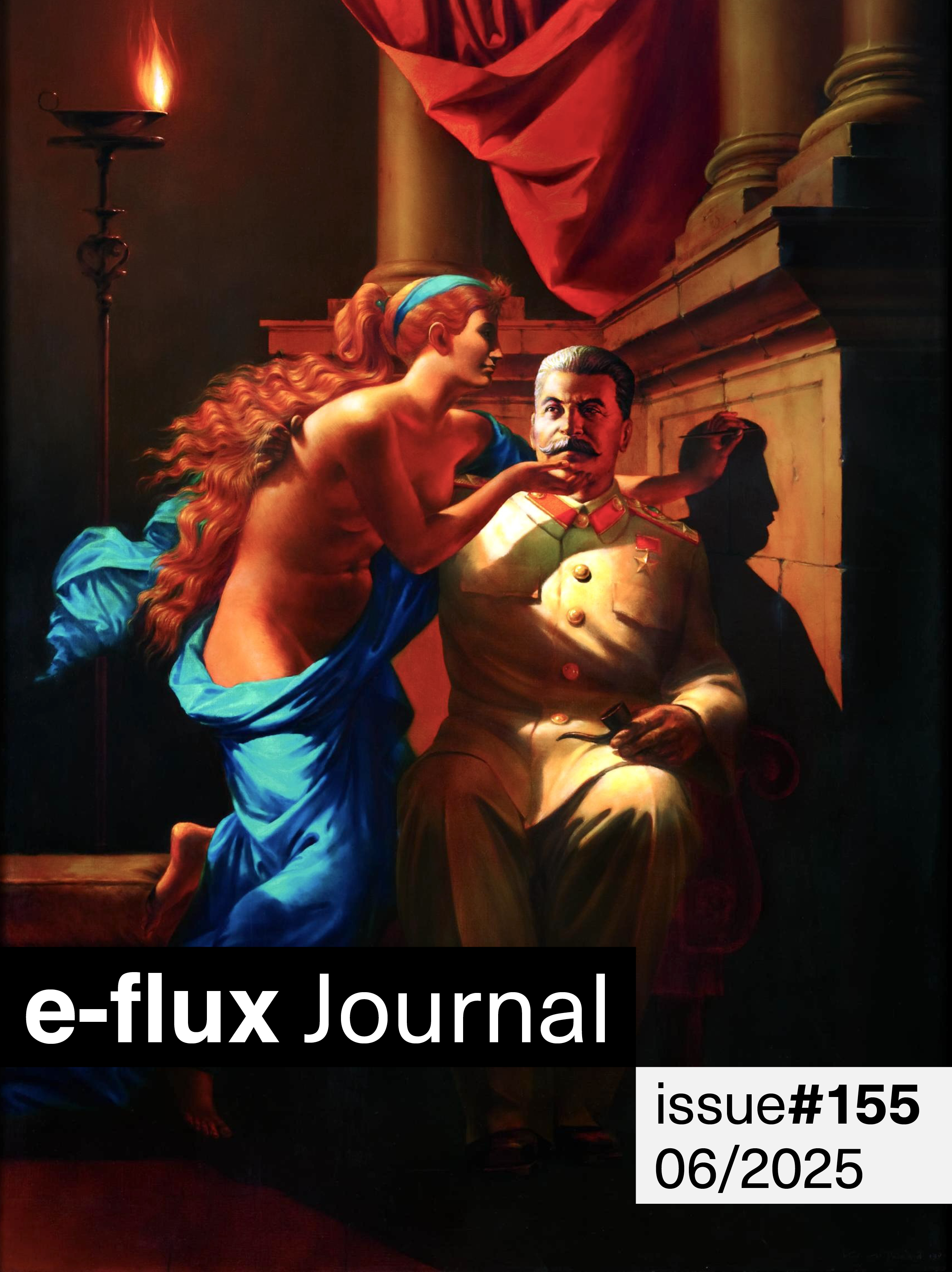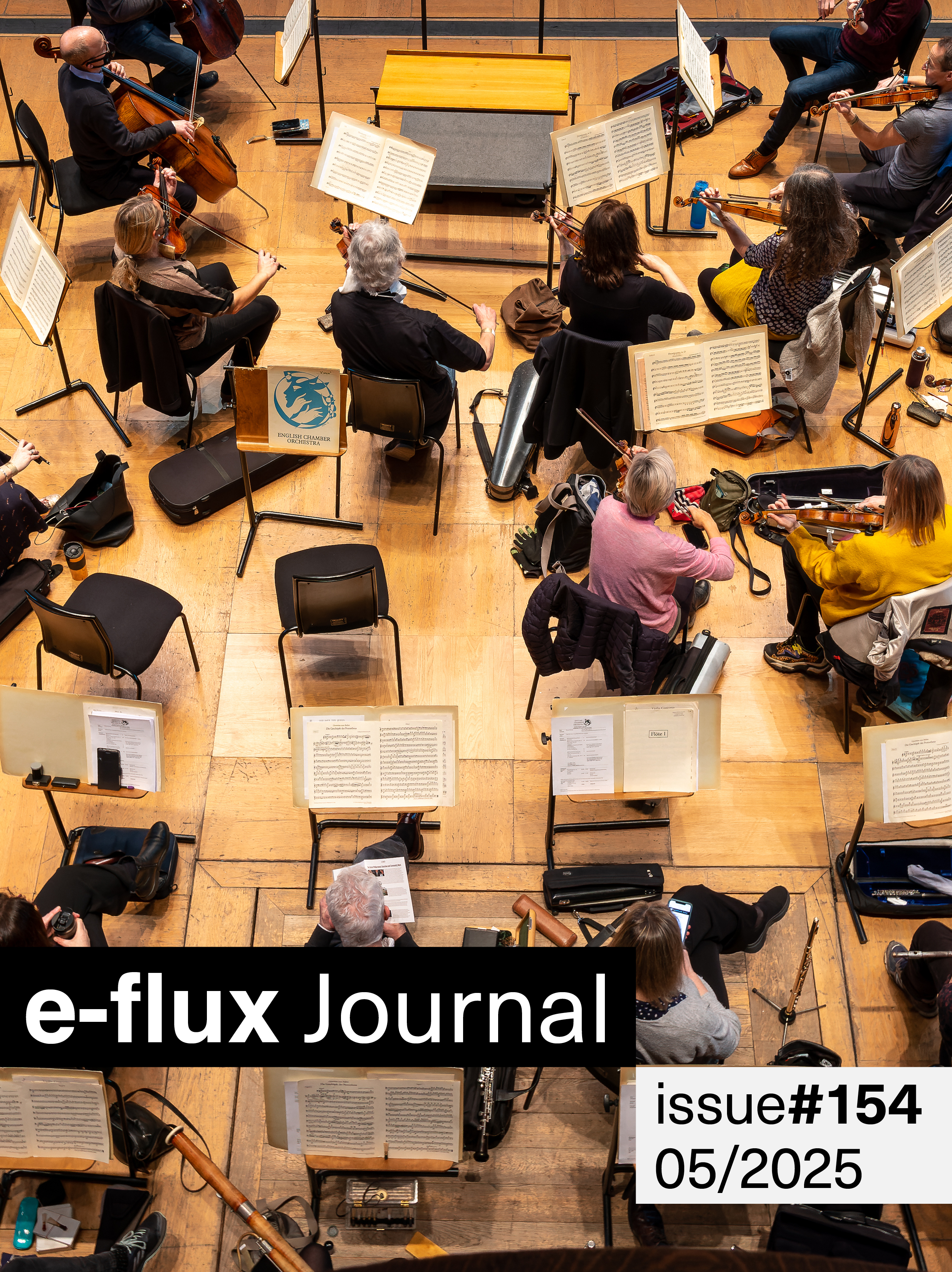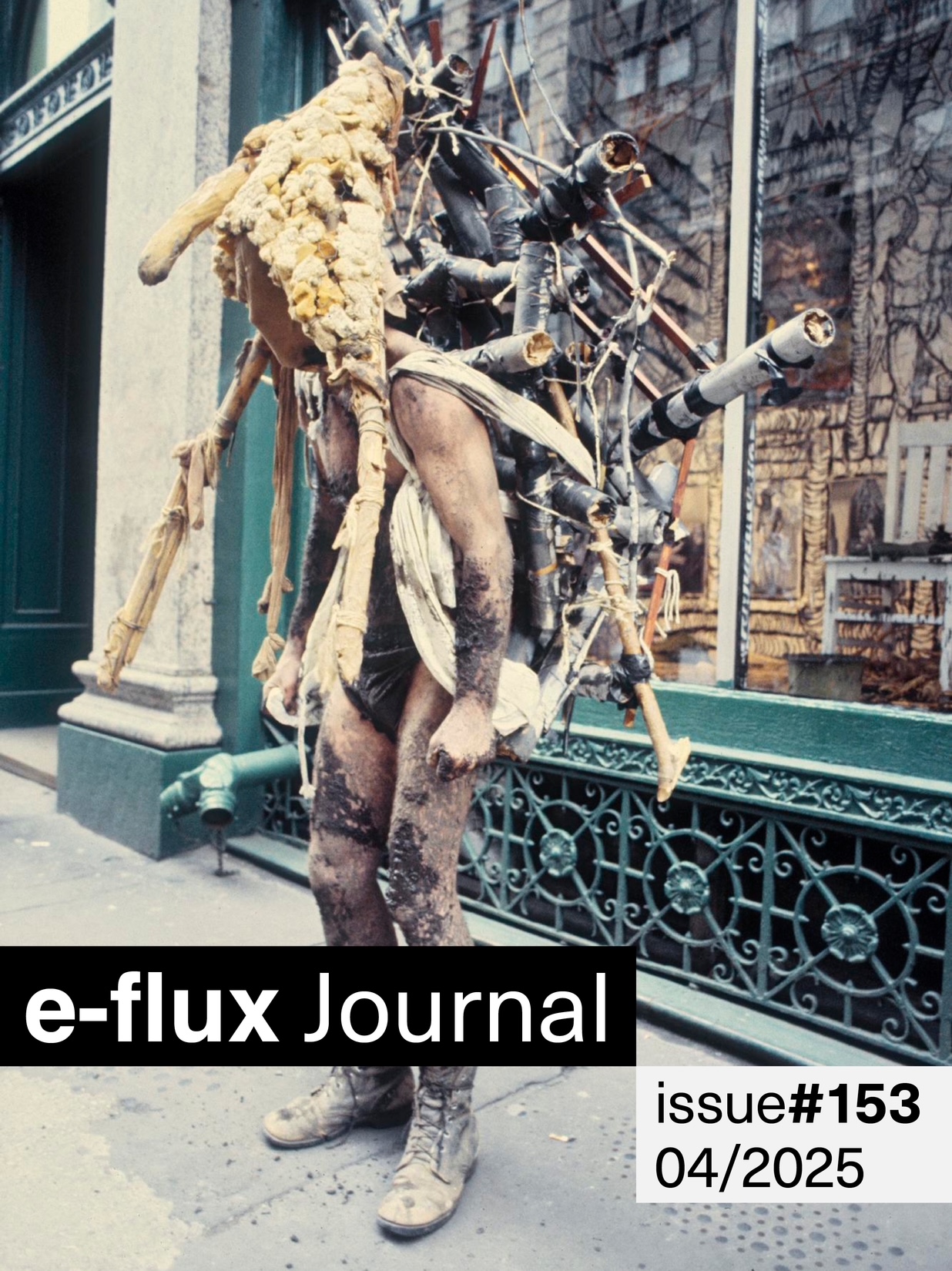e-flux journal issue 92: “on feminisms”
with Pilar Villela Mascaró, Griselda Pollock, Renee Gladman, Mary Walling Blackburn, Elizabeth A. Povinelli, Elvia Wilk, Mirene Arsanios, Élisabeth Lebovici and Giovanna Zapperi, Irmgard Emmelhainz, Angela Dimitrakaki, Chus Martínez, Ewa Majewska, and Simone White
In ten seconds, how many synonyms can you think of for the word “power”?
And then, just when you thought that you finally got the hang of how the power structures around you function, they seem to be coming undone. But are they really coming undone, or is the current that’s pushing and pulling at them not much more than a massage, a way to keep them up to date that stays only on the surface and is not able to touch the center?
What is feminism, precisely? What are feminisms today?
To answer these questions and myriad others, the next two issues of e-flux journal are dedicated to feminism(s). It is a particular pleasure to embark on an exploration and an unfolding of the many complex realities and iterations that feminism can accommodate. Not one feminism, but many.
Sexual violence and sexual harassment certainly take center stage in current public discourses around women, around power—around feminisms. Perhaps these problems are being highlighted not because they are the only important issues, but because, under some legal systems, sexual violence is one abuse of power that is attached to legal and social punitive consequences—however indirect or murky those consequences may be. Meanwhile, of course, it is not clear if the waves of calling out and achieving punitive results is provisional in lieu of structural change: Conversation is moving rapidly through viral/virtual channels, which is very different from the legal and social in the familiar sense. And of course in many countries the woman-as-victim is punished instead (see: honor crimes), and even in so-called “developed” countries women are often socially or legally punished.
But, though bodies may be separated—by screen or otherwise—the current recountings engender empathy, so that the bodies can stand shoulder to shoulder. The solidarity and recognition of our bodies in the bodies of others who together comprise half of the world’s population also helps do away with the rarified feeling of “being exceptional” where a successful woman may be the only one like herself in a male-dominated field (like the current prime minister of New Zealand, the first world leader in thirty years to give birth while in office). Being “the exception that proves the rule” is a dangerous position. We are in this together.
In 1615, the first English translation of Homer’s Odyssey appeared in print. In 2017, Mary Beard began Women and Power: A Manifesto, as follows: “I want to start very near the beginning of the tradition in Western literature, and its first recorded example of a man telling a woman to ‘shut up’; telling her that her voice was not to be heard in public. I am thinking of a moment immortalized at the start of Homer’s Odyssey, almost 3,000 years ago.” She goes on to describe Odysseus’s son, Telemachus, telling his mother Penelope to fuck off—he will handle it as only a man can (in this case, murderously; these murders, it turns out, are perpetrated against rape victims). Penelope was fending off suitors trying to claim her after the presumed death of her absent husband. Her female servants didn’t have that option—to fend off unwanted sex, to consent. Also in 2017, Emily Wilson published the first translation of The Odyssey by a woman. She completely revolutionizes our understanding of the violent scene that follows the exchange between Telemachus and his mother. Translation here is an ally—an accomplice—in reexamining the agency, action, complexity, consent, abuse of, and violence toward women of various classes and backgrounds as they appear in this ultimate classic. Crucially, in recounting Odysseus’s triumphant, sudden return to his palace from a ten-year philandering absence, Wilson reexamines the words he uses to order his son to kill the women who’ve fallen prey to the visiting suitors. Wilson, in returning to the words as intended, changes the Fagles-translation hurl of “sluts” and “whores” to the simpler, more accurate “girls”—a term reflecting the original Greek word meaning “female ones,” as well as the fact that these people would have been essentially slaves—almost certainly not of a position nor age to consent.(1) In the classic translation is the power of dismissal and violent misogyny (miso-gyny—seventeenth century, from the Greek: misos, “hatred” + gunē, “woman”).(2) In this new translation is the power of accurate language, of long-obscured truth.(3)
So, as translation and language are a form of power, here we aim toward embodying a powerful container, or a pole vault—as in a jump, an arc or ark—for the work and words of thinkers, artists, workers, mothers, poets, historians, collaborators, fighters, conveners, killjoys, teachers, those who dig futures, and those who feel archeological about feminisms—as well as those who have thoughtful reasons for not identifying with the term “feminism.” The issue contains writing on feminisms in many but certainly not all combinations of the term’s five-dimensional Venn diagrammatic modes. The “topic” (if the struggle of half of the world’s population can be simply described as a topic—or for that matter as a struggle) is of course so vast that we miss aspects of it. In recognition of this we also want to shed some light on all layers and problematics, loopholes, hits and misses that an issue like this entails.
We are interested in:
Productions, reproductions, lineages, of / by female images—or “the female image”—whether in graphic or graphic novel or science fiction form. As well as, of course, discourses on feminisms in contemporary art. In the production of the heroine image. We are interested in contemporary art motherhood. Contemporary working artists in motherhood. Contemporary mothers in the area of art. We are interested, on a planetary level, in the de-gendering of the planet as mother. Relatedly, there is consideration for levels of planetary damage and toxicity and recognition of the phenomenon of “menvironmentalism.” With a view beyond earth: the gendering and feminisms of / in / on other planets. We find fascination in the Androgynous Peripheral Attach System developed to dock Soyuz-Apollo crafts, built at an expense to the tune of 18 million USD, so that neither the vessel belonging to the United States of America, nor the Russian vessel had to be the penetrated one within the Shuttle-Mir docking mission. We look to feminist space (besides and including outer). We looked to investigation, reflection, real fight and flight and deep celebration; we sought and seek to listen to read and present a symphonic, dissonant, layered, maximal collection on feminisms. More feminisms to come in September, when e-flux journal issue #93 comes out.
Words of radical generosity and electric honesty are presented here. Synthesis and resonance and dissonance all at once, with archival deep dives into and between presents, pasts, futures.
Renee Gladman’s concise yet expansive universe of words conjures, remembers, and continues sung and under-sung traditions and trajectories that we need to hear, all the while providing a needed troubling of certain sodden figures.
We also remember here, editorially, why certain waters have been tread, why battles have been fought and reproduced, and why some of these (especially those around reproduction) have been, and are, so necessary and hard fought. And yet they are also understood here and by many today as one part of an aqueous ecosystem, where urgent and continuing narrative currents circulate, and have a chance to surface too.
To borrow the title of Angela Dimitrakaki’s piece in this issue, herein are “Feminism, Art, Contradictions.”
Griselda Pollock offers a thoughtful history of one such terrain, focused bodily and spread across several decades and geographies of both physical and artistic practice.
Continuing with contradictions, Pilar Villela Mascaró opens up deeply needed, uncomfortable complexities of living, working, thinking, having a body, and speaking (or not) in public at this time, while also shining a light onto the geographical and social contexts in Mexico and Latin America from which she writes. Mascaró troubles the word “feminism” with precise, difficult-to-express, ambivalent positions because, as she states, she cares about feminism so much—without identifying with it.
Mary Walling Blackburn’s “Sticky Notes, 1–3” turn a lived, ruthless gaze toward the dioramic terrains of nuclear power, implants, and people power (among others) pointed toward toxic and healing nodes alike: motherhood and activism focused in North America that resonate around other plants and forests.
Of course the very earth and cosmos as well as celestial beings and bodies have long been understood in terms of gender—often female. Elizabeth A. Povinelli explores Gaia together with Arendt’s concept of political activity through Greek, Indigenous, and European colonial taxonomies and realities.
Mirene Arsanios presents “E autobiography di un idioma”—language as body as narrator, a part of fluent but not fluid matrilineal lineages and mother tongues. Arsanios’s story is an autobiography of the creole language Papiamentu.
Elvia Wilk reads Jeff VanderMeer’s novel Annihilation, and its (female) biologist’s deep inhalation of living text in (the Lem and Strugatsky–reminiscent) Area X, alongside female-authored mystical texts from the thirteenth and fourteenth centuries. In undertaking this journey into “The Word Made Fresh,” Wilk traces the long lineage—feminist and otherwise—behind the “New Weird” literary genre.
Ewa Majewska describes a revelatory moment experienced during a role-playing card game, and transfers this experience into the feminist paradox that is ultimately the necessity of wanting a whole radically feminist world, not just bits and pieces of it. Majewska traces the recent, growing, ongoing women’s movements, in Poland and globally, and offers an intellectual mapping for, as she writes, “What can be done. Now.”
Irmgard Emmelhainz considers the architectural (in)considerations and non-considerations of the bodily functions of womens’ and women-identified bodies, among other intimate and instructive revelations.
Chus Martínez points toward the reality that in a shifting post-fordist work landscape, equality is not a matter of numbers or representation, but is rather about something like terraforming the art institutional landscape, with an eye toward (re)creating new conditions in which women can lead.
Simone White’s poem “or, on being the other woman” lays out the multiple complex scores, sounds, dissonances, and necessities—intellectual and visceral—that relate to being, for example, a woman, a mother, and a working intellectual.
Élisabeth Lebovici and Giovanna Zapperi provide a full, contextualized picture of the negative solidarity expressed in an open letter published in Le Monde earlier this year that notoriously urged women to decry one another’s testimonies of sexual humiliation and harassment, all in the name of defending men’s sexual freedom to “disturb” women whenever and wherever they please. Of course, these negative solidarities give rise and risk to communal strangulation—the classic and despot-approved condition of divisions leading to fighting for scraps. But there could be—or rather there has been, and is, and will be—solidarity. We fight together, emboldened and embodied, for an equality defined not by mere numbers, but by the conditions we require to thrive.
Notably, in this issue of e-flux journal, multiple authors write about the demands and responsibilities they had to juggle—including caring for children—in order to write the texts you read here. We recognize and respect the varied, complex conditions that these writers, thinkers, and artists had to create for themselves, and we celebrate and appreciate the deep labor and time-based constraints that authors pushed through here.
In her last book of collected writings, Sounding the Margins (2010), North American composer Pauline Oliveros said of a sound practice she called “raw listening”:
“Raw listening, however, has no past or future. It is the roots of the moment. It has the potential of instantaneously changing the listener forever.
Here is one of my practices: Listen to everything until it all belongs together and you are part of it.”
—Julieta Aranda, Kaye Cain-Nielsen
(with thanks to the journal editorial staff and larger team at e-flux for generative reads and comments)
(1) As Wyatt Mason wrote in the New York Times Magazine: “Wilson, in her introduction, reminds us that these palace women—‘maidservants’ has often been put forward as a ‘correct’ translation of the Greek δμωαι, dmoai, which Wilson calls ‘an entirely misleading and also not at all literal translation,’ the root of the Greek meaning ‘to overpower, to tame, to subdue’—weren’t free. Rather, they were slaves, and if women, only barely. Young female slaves in a palace would have had little agency to resist the demands of powerful men. Where Fagles wrote ‘whores’ and ‘the likes of them’ … the original Greek, Wilson explained, is just a feminine definite article meaning ‘female ones.’ To call them ‘whores’ and ‘creatures’ reflects, for Wilson, ‘a misogynistic agenda’: their translators’ interpretation of how these females would be defined.” W. Mason, “The First Woman to Translate The Odyssey into English,” New York Times Magazine, November 2, 2017.
(2) Robert Fagles’s translation of Telemachus’s echoing his father’s command to kill: “No clean death for the likes of them, by god!/Not from me — they showered abuse on my head, my mother’s too!/You sluts—the suitors’ whores!” By contrast, Emily Wilson’s translation: “‘I refuse to grant these girls a clean death, since they poured down shame on me and Mother, when they lay beside the suitors.’” At that, he wound a piece of sailor’s rope round the rotunda and round the mighty pillar, stretched up so high no foot could touch the ground. As doves or thrushes spread their wings to fly home to their nests, but someone sets a trap—they crash into a net, a bitter bedtime; just so the girls, their heads all in a row, were strung up with the noose around their necks to make their death an agony. They gasped, feet twitching for a while, but not for long.”
(3) For more on translation and power see, for example, Translation, History and Culture. eds. Susan Bassnett and André Lefevere (Continuum, 1998); Translation and Power, eds. Maria Tymoczko and Edwin Gentzler (University of Massachusetts Press, 2002).
Pilar Villela Mascaró—“One Eye Closed: An Exercise in Stereoscopy”
I have trouble calling myself a feminist. But it’s not the same trouble I have calling myself a Latina, or for that matter the same trouble I have trying to position myself in the oh-so-American, colonial, and already biased notion of a scale of privilege. And I firmly believe that one should be particularly wary of any appeal to biological determinants in order to establish an excuse for domination or exploitation. I do not own my body, but neither do you. I have trouble calling myself a feminist because I take feminism very seriously.
Griselda Pollock—“Action, Activism, and Art and/as Thought: A Dialogue with the Artworking of Sonia Khurana and Sutapa Biswas and the Political Theory of Hannah Arendt”
The polis is not an institution but an event. This is why telling stories about what has been is so crucial. Narratives create a memory of such events, like feminism, or 1968, or 1989. But we can create a bad memory of the event, failing to keep its virtuality alive. Thus, how we narrate to each other the political moments of such gathering and political appearance and movement will determine its future power or its meaning. I propose instead that we imagine feminism as a space, a landscape, variously populated by different settlements of speech and action, with many different routes of connection and even walls of agonistic division. It is a space of diversity and movement, not a single story of development or failure, or generational antagonism.
Renee Gladman—“Untitled (Environments)”
And I found in my narrative these other narratives that opened under water, that glowed in deepest night, that you could read without alarm, that were blown-out geometries, maps, that were textiles hanging from the ceiling, calendula underground, always having something to do with bodies, moving through other bodies.
Mary Walling Blackburn—“Sticky Notes, 1–3”
Blanche Wittman wrote, after being written on. Her yellow, black, and red notebooks, found after her death, have not been translated from the French into English. Before she was a technician and a writer, male physicians induced a trance and traced on her chest, with the point of a pin. Their words are subtitles? She is an object within the animation instigated by their hypnosis? There is nothing maieutic about my line of inquiry; no men will give birth to truth. Later, blank (page) again, Blanche (white) lives as irradiated hunk in Marie Curie’s apartment. In the living quarters is Marie Curie’s cookbook. It is still too radioactive for contemporary researchers to leaf through. Academics, bankrolled by research grants, enter the archive. They cannot touch where Blanche touched without protection. But some don’t care to investigate; they find the white body, the white female body, the dead white female body, dead white feminism, white feminism, feminism tapped out, over researched, and over-resourced, at best.
Elizabeth A. Povinelli—“Mother Earth: Public Sphere, Biosphere, Colonial Sphere”
Alongside the Greek cosmos are other dwellers of world and earth—Dene, Sioux, Ogoni, Karrabing, and so many others. For them, the catastrophe Arendt warns against has already happened—it resulted from the geontological presumptions that invaders brought with them and fabricated their governance out of. The cascading effects of colonization were just now creeping up on Arendt’s moderns. Maybe the problem wasn’t letting the animal laborans take over and transform the rationale of politics, but rather thinking that someone or something has to be assigned the role of providing the biological conditions of someone else’s life—that someone must do labor and be the milk for me—and that someone or something can be found to play that role without harm.
Elvia Wilk—“The Word Made Fresh: Mystical Encounter and the New Weird Divine”
Faced with the possible annihilation of the planet as we know it, certain modes of knowing fall short. Especially insufficient is knowledge that purports humans to be distinct from ecosystems, much less in control of them. Among the “surprises and ironies at the heart of all knowledge production,” says Donna Haraway, is the fact that “we are not in charge of the world.” A mysticism for the Anthropocene, just like mysticism through the ages, would regard the “object” of knowledge as alive and inseparable from the mind and body that encounters it. That is, rather than fictionalizing science, a mysticism for today would have to Weird it.
Mirene Arsanios—“E autobiography di un idioma”
I would have liked to come to you (abo) with something more reliable, like documents (akto), but I’m an oral language (idioma)—an Afro-Portuguese proto-creole developed on the western coast (kosta) of Africa and brought over to the Caribbean in the seventeenth century. That’s one of the theories of my genesis. There are others (otronan). Dutch and Spanish tagged along at later stages, with a few Arawak words (palabranan). Initially, slave traders and slaves used me to “communicate”; then I was just used (merka). The only document in my possession says I was born on the island of Curaçao, north of the Venezuelan shore. Linguists struggle to match my identity to a location. Words travel and land in places (luganan) that do not match their jurisdiction (a nation (nashon)-state).
Élisabeth Lebovici and Giovanna Zapperi—“Maso and Miso in the Land of Men’s Rights”
Let’s face it: we were in shock after reading the infamous, collectively authored column—aka “Deneuve’s text”—published in the French newspaper Le Monde last January, defending the (male) right to “disturb” as a way to dismiss women’s struggles against sexual abuse. As a response to the Weinstein affair and the emergence of the #MeToo movement, a group of one hundred women, mostly high-profile professionals from the fields of art and culture, argued in favor of the male “freedom to disturb” (in French, importuner) as “indispensable for sexual freedom.” Such a virulent declaration of normative heterosexuality (one of its main subtexts reads, “We are not lesbians”) and its equally violent anti-feminism made us sick. The column’s claim for a gender-exclusive type of freedom ironically resonates with the national rhetoric of “droits de l’Homme” (rights of Man), an expression coined during the French revolution still widely used to mean “human rights.”
Irmgard Emmelhainz—“Dragging (My) Shadows on a Circle: On Anger, Vulnerability, and Intimacy”
I find it terrifying that the root of the sex/gender divide harks back to the modern conception of man as “reason.” Fully dissociated from the body, the ideal condition of “man” translates to the ideal of “woman” as pure consciousness. If we speak of situated knowledges rather than universalizing scientific, Eurocentric, and masculine visions, could we embrace a kind of situated biology that would consider not only two or three sexes, but myriad sexes that could be expressed limitlessly through our bodies? And from what standpoint could we organize a political struggle that would have as its goal a society that would celebrate, support, and value reproduction instead of negating it and undermining it? I know; I always demand too much.
Angela Dimitrakaki—“Feminism, Art, Contradictions”
Understanding art as a field (of socialized human action) defined by contradictions bears on how feminism is organized as political practice within this field. Notably, some of art’s contradictions are not experienced exclusively by feminism, but also by emancipatory politics at large. Nonetheless, thinking about contradictions in relation to the specificity of the feminist struggle in art—a struggle that has carried on, in its various forms, for at least half a century—might help put into perspective the dialectic of gains and losses perceived as the art history of feminism as much as compel a historical contextualization of feminist agency and of where its allies should be sought.
Chus Martínez—“But Still, Like Air, I’ll Rise”
Equality is definitely not synonymous with the “same”; nor does it correspond to the idea of a “fifty/fifty” share. Rather, equality implies the process of arriving at a place where the conditions and the virtues of our work are perceived as equivalent to those of our male counterparts. Therefore, it is not only a question of securing certain numbers, but of also securing the conditions, the laws, and the language that bring about equality. We need to engage in the elaboration and the practical realization of a whole host of measures that can only be accomplished through excess—an excess of care, of attentiveness to needs—in order to reshape individual and collective behavior as well as the imagination of power and its management.
Ewa Majewska—“Feminism Will Not Be Televised”
The transformation of the public sphere by women who do not hesitate to show their affect, who speak with and/or without sense, who supported the man they love as long as they could and obeyed their father as far as they were socialized to do, amounts to another inclusion of women into a sphere where they do not belong. An audience might have had mixed feelings when looking at those twelve women performing Ophelia in quick succession, but one thing definitely became clear to every viewer: in those given conditions, we cannot win. Whether we are big or small, old or young, passive or aggressive, or both, we can’t win in a game whose rules have been written within a patriarchal script, one in which we don’t belong. There is only one thing to be done: we must turn the tables of the social staging of the public sphere, undermining its gendered, normative framework.
Simone White—“or, on being the other woman”
monitoring a stink Bug’s progress, or, beautiful random application of remorseless violence: / there. my boy has begun to apprehend such concepts as affection, better identified as interested longing, does this / one like me? maybe he doesn’t like me? lOok the Buug-h. windy undifferentiated consonants unsorted / words please me so. one day i will tell how much time was there before he could evoke in me anything like / interest. his thought interests me, i date from discussion of the need to use a pot or toilet for shit. in a few days i / would fall into a rage on the street arguing with my mother on the telephone. / what makes me if her desire vibrates as pleading packed in insult










